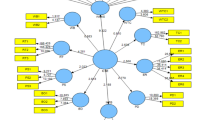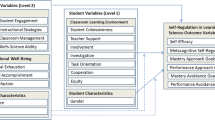Abstract
This study focuses on preservice teachers’ self-efficacy and its development throughout the course of a school-internship. Based on previous findings, we expected that preservice teachers’ self-efficacy would increase during their internship. Moreover, we argued that this initial development of self-efficacy would be associated with the way the first teaching experiences are attributed to different causes as well as to preservice teachers’ implicit theories of intelligence. To this end, surveys with N = 162 German preservice teachers were conducted at the beginning and at the end of their 17-week internship. Results revealed an increase of self-efficacy throughout the course of the internship. Using a structural equation model, self-efficacy at the end of the internship was significantly predicted by self-efficacy at the beginning as well as by attributing successes to internal, stable, and controllable causes, but not by an incremental theory of intelligence. Implications for further research and teacher education are discussed.
Abstract
Diese Studie adressiert die Selbstwirksamkeitserwartung von Lehramtsstudierenden sowie ihre Entwicklung während des Semesterpraktikums. Basierend auf den Forschungsergebnissen vorheriger Studien wurde ein Anstieg der Selbstwirksamkeitserwartung vermutet. Darüber hinaus wurde ein Zusammenhang dieser anfänglichen Entwicklung der Selbstwirksamkeitserwartung mit den Attributionsmustern, mit welchen die ersten Unterrichtserfolge erklärt wurden, sowie den impliziten Intelligenztheorien der Studierenden erwartet. Zu diesem Zweck wurden Fragebogenerhebungen mit N = 162 Lehramtsstudierenden aus Deutschland zu Beginn und am Ende ihres 17-wöchigen Schulpraktikums durchgeführt. Dabei zeigte sich ein Anstieg der Selbstwirksamkeitserwartung über den Praktikumszeitraum. In einem Strukturgleichungsmodell wurde die Selbstwirksamkeitserwartung am Ende des Praktikums signifikant von der Selbstwirksamkeitserwartung zu Beginn des Praktikums sowie von der Attribuierung von Erfolgen auf internale, stabile und kontrollierbare Ursachen vorhergesagt, nicht aber von einer veränderbaren Intelligenztheorie. Abschließend werden Implikationen für die weitere Forschung sowie die Lehrerbildung diskutiert.

Similar content being viewed by others
References
Abramson, L. Y., Seligman, M. E. P., & Teasdale, J. D. (1978). Learned helplessness in humans: Critique und reformulation. Journal of Abnormal Psychology, 87, 49–74.
Allinder, R. M. (1994). The relationship between efficacy and the instructional practices of special education teachers and consultants. Teacher Education and Special Education, 17, 86–95.
Bach, A. (2013). Kompetenzentwicklung im Schulpraktikum: Ausmaß und zeitliche Stabilität von Lerneffekten hochschulischer Praxisphasen. Münster: Waxmann.
Bandura, A. (1977a). Self-efficacy: Toward a unifying theory of behavioral change. Psychological Review, 84, 191–215.
Bandura, A. (1977b). Social learning theory. Englewood Cliffs: Prentice-Hall.
Bandura, A. (2012). Self-efficacy: The exercise of control (12th edn.). New York: Freeman.
Baumert, J., & Kunter, M. (2013). The COACTIV model of teachers’ professional competence. In M. Kunter, J. Baumert, W. Blum, U. Klusmann, S. Krauss & M. Neubrand (Eds.), Cognitive activation in the mathematics classroom and professional competence of teachers: Results from the COACTIV project (pp. 25–48). New York: Springer.
Blackwell, L. S., Trzesniewski, K. H., & Dweck, C. S. (2007). Implicit theories of intelligence predict achievement across an adolescent transition: A longitudinal study and an intervention. Child Development, 78, 246–263.
Burnette, J. L., O’Boyle, E. H., VanEpps, E. M., Pollack, J. M., & Finkel, E. J. (2013). Mind-sets matter: A meta-analytic review of implicit theories and self-regulation. Psychological Bulletin, 139, 655–701.
Byrne, B. M., Shavelson, R. J., & Muthén, B. (1989). Testing for the equivalence of factor covariance and mean structures: The issue of partial measurement invariance. Psychological Bulletin, 105, 456–466.
Chen, F. F. (2007). Sensitivity of goodness of fit indexes to lack of measurement invariance. Structural Equation Modeling, 14, 464–504.
Chen, J. A., & Tutwiler, S. M. (2017). Implicit theories of ability and self-efficacy. Zeitschrift für Psychologie, 225, 127–136.
Cheung, G. W., & Rensvold, R. B. (2002). Evaluating goodness-of-fit indexes for testing measurement invariance. Structural Equation Modeling, 9, 233–255.
Ding, K., Rohlfs, C., & Spinath, B. (2018). Selbstwirksamkeitserwartungen und Attributionsstile von Lehramtsstudierenden. In I. Biederbeck & M. Rothland (Eds.), Praxisphasen in der Lehrerbildung im Fokus der Bildungsforschung (pp. 57–68). Münster: Waxmann.
Dinger, F. C., & Dickhäuser, O. (2013). Does implicit theory of intelligence cause achievement goals? Evidence from an experimental study. International Journal of Educational Research, 61, 38–47.
Diseth, Å., Meland, E., & Breidablik, H. J. (2014). Self-beliefs among students: Grade level and gender differences in self-esteem, self-efficacy and implicit theories of intelligence. Learning and Individual Differences, 35, 1–8.
Dweck, C. S., Chiu, C.-Y., & Hong, Y.-Y. (1995). Implicit theories and their role in judgements and reactions: A world from two perspectives. Psychological Inquiry, 6, 267–285.
Fineburg, A. (2010). Examining explanatory style’s relationship to efficacy and burnout in teachers (Doctoral dissertation, University of Alabama). http://acumen.lib.ua.edu/content/u0015/0000001/0000225/u0015_0000001 _0000 225.pdf. Accessed 20 Oct 2016.
Fives, H. (2003). What is teacher efficacy and how does it relate to teachers’ knowledge? A theoretical review. Paper presented at the Annual Conference of the American Educational Research Association, Chicago. https://pdfs.semanticscholar.org/0eab/86da65c8cb4b45ba9936227c2189d6eb544c.pdf. Accessed 30 Nov 2016.
Fives, H., Hamman, D., & Olivarez, A. (2007). Does burnout begin with student-teaching? Analyzing efficacy, burnout, and support during the student-teaching semester. Teaching and Teacher Education, 23, 916–934.
Flores, I. M. (2015). Developing preservice teachers’ self-efficacy through field-based science teaching practice with elementary students. Research in Higher Education Journal, 27. http://www.aabri.com/rhej.html. Accessed 20 Nov 2017.
Gibson, S., & Dembo, M. H. (1984). Teacher efficacy: A construct validation. Journal of Educational Psychology, 76, 569–582.
Hirschy, A. J., & Morris, J. R. (2002). Individual differences in attributional style: The relational influence of self-efficacy, self-esteem, and sex role identity. Personality and Individual Differences, 32, 183–196.
Hong, Y.-Y., Dweck, C. S., Chiu, C.-Y., Lin Derrick, M.-S., & Wan, W. (1999). Implicit theories, attributions, and coping: A meaning system approach. Journal of Personality and Social Psychology, 77, 588–599.
Houston, D. M. (1995). Surviving a failure: Efficacy and a laboratory based test of the hopelessness model of depression. European Journal of Social Psychology, 25, 545–558.
Hu, L., & Bentler, P. M. (1999). Cutoff criteria for fit indexes in covariance structure analysis: Conventional criteria versus new alternatives. Structural Equation Modeling, 6, 1–55.
King, R. B., McInerney, D. M., & Watkins, D. A. (2012). How you think about your intelligence determines how you feel in school: The role of theories of intelligence on academic emotions. Learning and Individual Differences, 22, 814–819.
Klassen, R. M., & Tze, V. M. (2014). Teachers’ self-efficacy, personality, and teaching effectiveness: A meta-analysis. Educational Research Review, 12, 59–76.
Klassen, R. M., Tze, V. M., Betts, S. M., & Gordon, K. A. (2011). Teacher efficacy research 1998–2009: Signs of progress or unfulfilled promise? Educational Psychology Review, 23, 21–43.
Knoblauch, D., & Chase, M. A. (2015). Rural, suburban, and urban schools: The impact of school setting on the efficacy beliefs and attributions of student teachers. Teaching and Teacher Education, 45, 104–114.
Knoblauch, D., & Woolfolk Hoy, A. (2008). “Maybe I can teach those kids.” The influence of contextual factors on student teachers’ efficacy beliefs. Teaching and Teacher Education, 24, 166–179.
Künsting, J., Neuber, V., & Lipowsky, F. (2016). Teacher self-efficacy as a long-term predictor of instructional quality in the classroom. European Journal of Psychology of Education, 31, 299–322.
Leroy, N., Bressoux, P., Sarrazin, P., & Trouilloud, D. (2007). Impact of teachers’ implicit theories and perceived pressures on the establishment of an autonomy supportive climate. European Journal of Psychology of Education, 22, 529–545.
Little, T. D., Cunningham, W. A., Shahar, G., & Widaman, K. F. (2002). To parcel or not to parcel: Exploring the question, weighing the merits. Structural Equation Modeling, 9, 151–173.
McAuley, E., Duncan, T. E., & McElroy, M. (1989). Self-efficacy cognitions and causal attributions for children’s motor performance: An exploratory investigation. The Journal of Genetic Psychology, 150, 65–73.
Neves de Jesus, S. N., & Lens, W. (2005). An integrated model for the study of teacher motivation. Applied Psychology: An International Review, 54, 119–134.
Pendergast, D., Garvis, S., & Keogh, J. (2011). Pre-service student-teacher self-efficacy beliefs: An insight into the making of teachers. Australian Journal of Teacher Education, 36, 46–57.
Peterson, C., Semmel, A., von Baeyer, C., Abramson, L. Y., Metalsky, G. I., & Seligman, M. E. P. (1982). The attributional style questionnaire. Cognitive Therapy and Research, 6, 287–299.
Pintrich, P. R., & Schunk, D. H. (1996). Motivation in education: Theory, research, and applications. Englewood Cliffs: Prentice-Hall.
Reyna, C., & Weiner, B. (2001). Justice and utility in the classroom: An attributional analysis of the goals of teachers’ punishment and intervention strategies. Journal of Educational Psychology, 93, 309–319.
Schulte, K. (2008). Selbstwirksamkeitserwartungen in der Lehrerbildung. Zur Struktur und dem Zusammenhang von Lehrer-Selbstwirksamkeitserwartungen, Pädagogischem Professionswissen und Persönlichkeitseigenschaften bei Lehramtsstudierenden und Lehrkräften (Doctoral dissertation, Georg-August-Universität, Göttingen). https://ediss.uni-goettingen.de/bitstream/handle/11858/00-1735-0000-0006-AD1A-3/schulte.pdf?sequence=1. Accessed 14 Aug 2016.
Schunk, D. H. (1983). Ability versus effort attributional feedback: Differential effects on self-efficacy and achievement. Journal of Educational Psychology, 75, 848–856.
Schwab, S., & Helm, C. (2015). Überprüfung von Messinvarianz mittles CFA und DIF-Analysen. Empirische Sonderpädagogik, 7, 175–193.
Schwarzer, R., & Hallum, S. (2008). Perceived teacher self-efficacy as a predictor of job stress and burnout: Mediation Analyses. Applied Psychology, 57, 152–171.
Schwarzer, R., & Schmitz, G. S. (1999). Lehrer-Selbstwirksamkeit. Dokumentation der Skala Lehrer-Selbstwirksamkeit (WirkLehr). Leibniz-Zentrum für Psychologische Information und Dokumentation (ZPID). http://www.zpid.de/pub/tests/pt_1003tWirkLehr.pdf. Accessed 20 Oct 2016.
Silver, W. S., Mitchell, T. R., & Gist, M. E. (1995). Responses to successful and unsuccessful performance: The moderating effect of self-efficacy on the relationship between performance and attributions. Organizational Behavior and Human Decision Process, 62, 286–299.
Skaalvik, E. M., & Skaalvik, S. (2007). Dimensions of teacher self-efficacy and relations with strain factors, perceived collective teacher efficacy, and teacher burnout. Journal of Educational Psychology, 99, 611–625.
Spinath, B. (2001). Implizite Theorien über die Veränderbarkeit von Intelligenz und Begabung als Bedingungen von Motivation und Leistung. Lengerich: Pabst.
Steenkamp, J.-B. E. M., & Baumgartner, H. (1998). Assessing measurement invariance in cross‐national consumer research. Journal of Consumer Research, 25, 78–107.
Tabernero, C., & Wood, R. E. (1999). Implicit theories versus the social construal of ability in self-regulation and performance on a complex task. Organizational Behavior and Human Decision Processes, 78, 104–127.
Tschannen-Moran, M., & Hoy, W. A. (2001). Teacher efficacy: Capturing an elusive construct. Teaching and Teacher Education, 17, 783–805.
Tschannen-Moran, M., & Woolfolk Hoy, A. W. (2007). The differential antecedents of self-efficacy beliefs of novice and experienced teachers. Teaching and Teacher Education, 23, 944–956.
Tschannen-Moran, M., Woolfolk Hoy, A., & Hoy, W. K. (1998). Teacher efficacy: Its meaning and measure. Review of Educational Research, 68, 202–248.
Wang, H., Hall, N. C., & Rahimi, S. (2015). Self-efficacy and causal attributions in teachers: Effects on burnout, job satisfaction, illness, and quitting intentions. Teaching and Teacher Education, 47, 120–130.
Weiner, B. (1985). An attributional theory of achievement motivation and emotion. Psychological Review, 92, 548–573.
Weiner, B. (1994a). Motivationspsychologie (3rd edn.). Weinheim: Beltz.
Weiner, B. (1994b). Integrating social and personal theories of achievement striving. Review of Educational Research, 64, 557–573.
Weiner, B. (2014). The attribution approach to emotion and motivation: History, hypotheses, home runs, headaches/heartaches. Emotion Review, 6, 353–361.
Woolfolk Hoy, A., & Spero, R. B. (2005). Chances in teacher efficacy during the early years of teaching: A comparison of four measures. Teaching and Teacher Education, 21, 343–356.
Woolfolk, A., Rosoff, B., & Hoy, W. K. (1990). Teachers’ sense of efficacy and their beliefs about managing students. Teaching and Teacher Education, 6, 137–148.
Zee, M., & Koomen, H. M. Y. (2016). Teacher self-efficacy and its effects on classroom processes, student academic adjustment, and teacher well-being: A synthesis of 40 years of research. Review of Educational Research, 86, 981–1015.
Author information
Authors and Affiliations
Corresponding author
Rights and permissions
About this article
Cite this article
Ding, K., Rohlfs, C. & Spinath, B. Preservice teachers’ self-efficacy: predicting changes over the internship period through attributional styles and implicit theories of intelligence. Z f Bildungsforsch 9, 329–344 (2019). https://doi.org/10.1007/s35834-019-00254-2
Received:
Revised:
Accepted:
Published:
Issue Date:
DOI: https://doi.org/10.1007/s35834-019-00254-2




